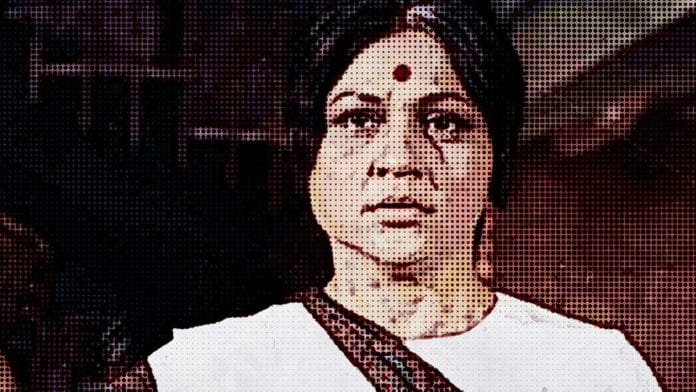ThePrint takes a look at Nirupa Roy’s career that was defined by her role in Yash Chopra’s Deewar.
In the history of Hindi films, few archetype characters have had as exalted a status as that of a mother. On screen, the word ‘mother’ was synonymous with actor Nirupa Roy for at least a couple of decades, if not more.
Most famous for co-starring with superstar Amitabh Bachchan over several films, Roy essayed the role of a mother in Bollywood films in a way that became her own — an image of a suffering motherhood that not only played an essential part in the narrative, but also pushed it forward.
Such was her image that even when filmmakers and actors and stories changed, Roy remained the primary choice for the protagonist’s mother in Bollywood films.
On her 88th birth anniversary, ThePrint takes a look at the actor’s career that was born out of a mere coincidence.
Early career
Roy was born on 4 January 1931 as Kokila Kishorechandra Balsara in Gujarat’s Valsad. After her marriage to a certain Kamal Roy at the age of 15, she moved to Bombay (now Mumbai).
As they tried their luck in the metro, Roy and her husband auditioned in response to an advertisement for actors in a Gujarati paper. The actress is believed to have started her career with the Gujarati film Ranakdevi in 1946. She acted in her first Hindi film, Amar Raj, the same year.
However, it was her role as a housewife who wins back her husband in Gunsundari (1948) that defined Roy as a star in the early part of her career.
Her role as Goddess Parvati in Jayant Desai’s Har Har Mahadev (1950) with actor Trilok Kapoor as Lord Shiv became so popular that people everywhere started seeking blessings from her, treating her like an actual goddess.
Roy also played the characters of several Hindu goddesses such as Sita and Lakshmi, and historical figures such as Meera Bai over the next few years.
Her portrayal of a poor rural housewife in legendary director Bimal Roy’s Do Bigha Zamin (1953), alongside veteran Balraj Sahni, brought her much acclaim.
She went on to star in several films with actor Bharat Bhushan, including Samrat Chandragupt (1958) and Rani Rupmati (1959).
Also read: Prithviraj Kapoor: The monarch of Hindi cinema and titan of stirring theatre
The mother
As her career progressed, Roy started playing the archetypal mother characters, perhaps propelled by her on-screen ‘goddess’ image.
Her first role as a mother was in the film Munimji (1955) with screen idol Dev Anand, who was seven years older to her. She went to play on the the role of a mother in numerous commercial films from thereon.
Her popular films in the next decade included one of the most landmark ‘double role’ films of all time — Ram Aur Shyam (1967), featuring Dilip Kumar, who was the industry’s reigning star at the time.
However, the film that made Roy India’s most popular mother was director Yash Chopra’s Deewar (1975). Written by the iconic screenwriting duo Salim-Javed and starring Bachchan as an anti-hero, Deewar gave her the role she would be remembered for. Her melodramatic turn as a widow torn between her elder son Vijay, who is a criminal, and his younger sibling Ravi, who is a police official, was a memorable one.
Roy went to play Bachchan’s mother in films such as Amar Akbar Anthony (1977) and Mard (1985).
Work dried up over the next few years. However, she returned to play Bachchan’s mother in Lal Badshah (1999). Such was her association with Bachchan that many thought she was actually related to him.
Drama in real life
After a long and successful film career, which included honours like the Filmfare Lifetime Achievement Award, Roy died of cardiac arrest on 13 October 2004.
Ironically, the situation after her death had echoes of her reel life, with her sons Yogesh and Kiran squabbling over the possession of her Napean Sea Road apartment in Mumbai.
Also read: Comedy king Mehmood who earned more than the lead actors of his films







In real life there were reports she was more cruel with her daughter in law
Nirupa has always been less enjoyable to watch on screen than Dina Pathak, Achala Sachdev or even Leela Mishra. However, during a short period, she was just as indispensable as Pran and Helen.